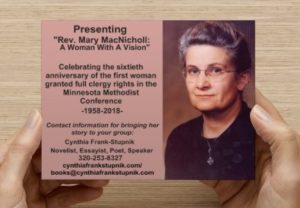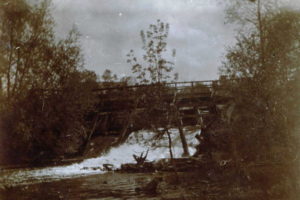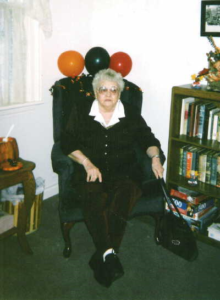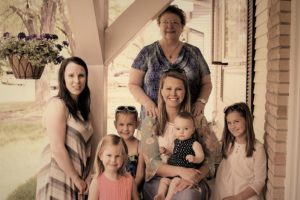
ON THE ROAD . . .
–TO RECOVERY–For those who didn’t know–
I finally had a knee replacement on May 3. Many of you saw me hobbling around. I’d have good days and bad days, but this winter was the worst. Not only had I needed this surgery for quite a while, but the knee had caused my ankle to degenerate from the reconstruction I had in 2005. This caused my podiatrist to have a brace designed and cast for me to wear to protect my ankle from further issues. My doctors, family, and I took special precautions in order to commit to my recovery–blood thinners due to a previous pulmonary embolism, intensive, in-house rehab physical therapy for 2 weeks 3 times a day, and when I was released to go home, lots of care and more physical therapy 3 times a week with my favorite PT. After 8 weeks of physical therapy, I’m doing great, and better yet, NO BOOT to protect the ankle.
–With REV. MARY MACNICHOLL-–
I am putting the final touches on the powerpoint slide presentation for the first woman to be fully ordained in the Minnesota Methodist Conference in 1958. Most of you know that I earned a grant from the United Methodist General Commission on Archives and History to write her story. Little did I know that this woman, Mary MacNicholl, who would be my minister in Clearwater, Minnesota, in the 1960s, had broken through her own ‘glass ceiling’. How did I know back then our church community would be served by such a celebrity? Not sure I or anyone else knew Mary Mac’s impact, but I know I felt honored to be noticed by her when I sang in the choir, attended Methodist Youth Fellowship, enrolled in our short confirmation class (Methodist youth usually have only a six-week education), she came to my graduation party, and when she often stopped to have coffee with my mom. She awoke our consciences, our awareness of the world around us, and our knowledge of our Methodist tradition. Sixty years after her ordination and forty years after her death, I hope to do justice to Mary MacNicholl’s story and service. The essay is ready to be sent to the United Methodist General Commission on Archives and History. The new and improved powerpoint will be tested when I speak at Wykoff United Methodist Church. This was one of the three churches Pastor Mary MacNicholl was charged with after she graduated from Drew Seminary in 1949. I will be presenting her story on July 21 during the church service at 8:30, a.m.
–BRINGING THE STORIES OF STRONG MINNESOTA MAIN STREET WOMEN TO MY READERS–
I was busy up to surgery–actually, less than a week before I sold my books at the St. Cloud River’s Edge Convention Center. Then the hiatus. Now, I am excited and ready to begin my busy time of the year–July through November.
After I present Mary MacNicholl’s story in Wykoff, I’ll be bringing my books, Minnesota Main Street Women series–Scruples & Drams and Pins & Needles, Around Clearwater, and Postcards from the Old Man to sell at the Clearwater Heritage Days at the Rendezvous at the dam, off Highway 75 and the north end of Main Street, Saturday and Sunday, August 3-4.
Come see me at the Clearwater dam where I’ll be participating in the Rendezvous. Here where the Clearwater River merges with the Mississippi, the village was first created. In the 1850s, sawmills lined the banks and built the first houses and store buildings. Feed mills, sawmills, stores of all kinds– hardware, general merchandise, jewelry, clothing, shoe, and furniture sat on the banks of the Clearwater or up on Oak Street and Main Streets. These buildings and the people who occupy them are the subjects of my Around Clearwater history and Minnesota Main Street Women series. Each protagonist, Jennie Phillips in Scruples & Drams and Maude Porter in Pins & Needles, a real woman pioneer from Clearwater, made her mark on the community. They both see gender inequalities in the world as far as suffrage, health, education, and legal issues. Their desire to make things right for the women and their families they encounter is a major theme in my series.
If you want to know history, Arcadia Publishing’s Image of America: Around Clearwater is the most up-to-date word on early Clearwater.” Burrowed below bluffs overlooking the Mississippi and Clearwater Rivers, Clearwater’s houses, its churches, and most of its original businesses resemble those that settlers had left behind in the East. With its arch-like trees sheltering Oak and Main Streets, the community remained home to many who lived and died there and those who had moved on only to return for yearly Old Settlers gatherings. This sense of community allowed Clearwater to thrive. Flour and pulp mills lined the shores of the Clearwater River. Mercantile, hardware, jewelry, and drug stores cropped up, providing the products for a growing community. Trade once powered by steamboats on the Mississippi was taken over by James Hills Great Northern Railroad. While the village and surroundings have changed over time, the original charm is still there, ready to be explored again.”
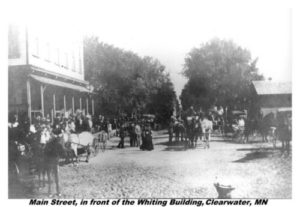
–WITH SOME FINAL THOUGHTS–
Speaking of Clearwater, Minnesota’s heritage that I have been writing about for a number of years, Clearwater’s Heritage Days is coming up August 2-3, with the Rendezvous lasting through Sunday. Along with coronation activities going on before the celebration begins, the parade comes back to downtown Clearwater on Friday night at 7:00 beginning at the Clearwater Dam. What a great move back to come back where the village began by the Clearwater and Mississippi Rivers. The parade route will begin there and end up at Eagle Trace Golf Course.
This length of Main Street will take you by many of the historic sites– past the Boutwell Hardware and Pat Quinn’s Saloon (neither are standing–that I write about in Maude Porter’s story, Pins & Needles. It will take you past the historic United Methodist Church I attended when I was in my youth, and down to the drug store (now an apartment building) I write about in Jennie Phillips’s, the woman druggist) story, Scruples & Drams. Three blocks further you will come to the Thomas Porter home and farm that he built beginning in the 1870s. He was a fur trader, farmer, village treasure and besides serving Wright County, and served in the Minnesota Legislature for a few terms. Your final stop will be at Eagle Trace Golf Club, which was his original land that extends down to the Mississippi River. I had trouble with the golf club’s webpage but this gives you at least the location: 1100 Main St. https://www.yelp.com/biz/eagle-trace-golf-and-event-center-clearwater
Come join us for some fun. I’ll keep up better from now on and let you in on the different spots I’ll be located over the next few months.
Cindy
P.S. Please “Subscribe” on my homepage.

